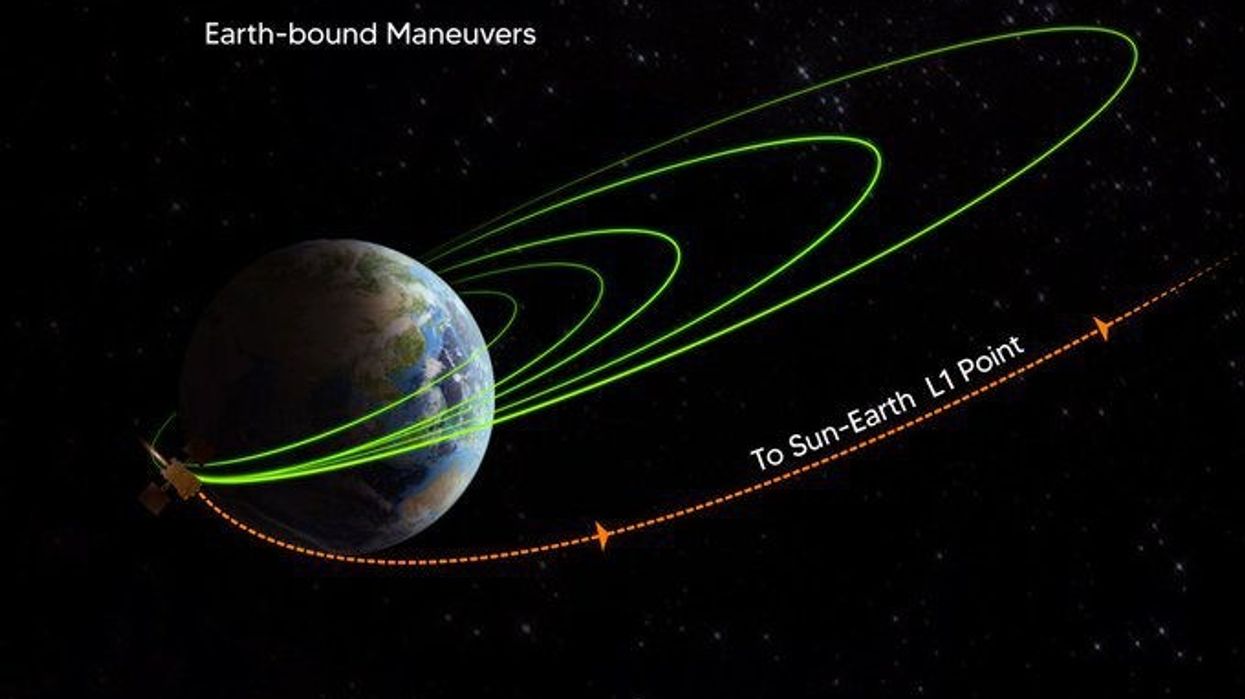The Aditya L1 spacecraft, India's first space-based mission aimed at studying the Sun, got a send-off from Earth after orbiting it since its September 2 launch, as it underwent a key manoeuvre in the early hours of Tuesday (19) ISRO said.
The Trans-Lagrangian Point 1 Insertion manoeuvre marks the beginning of the spacecraft's about 110-day trajectory to the destination around the L1 Lagrange point, a balanced gravitational location between the Earth and the Sun.
"Off to Sun-Earth L1 point! The Trans-Lagrangian Point 1 Insertion (TL1I) manoeuvre is performed successfully. The spacecraft is now on a trajectory that will take it to the Sun-Earth L1 point. It will be injected into an orbit around L1 through a manoeuvre after about 110 days," ISRO said in a post on Twitter.
This is the fifth consecutive time the Indian Space Research Organisation (ISRO) has successfully transferred an object on a trajectory toward another celestial body or location in space, the country's space agency said.
Aditya-L1 is the first Indian space-based observatory to study the Sun from a halo orbit around first Sun-Earth Lagrangian point (L1), located roughly 1.5 million km from earth, which is about one per cent of the Earth-Sun distance.
The Sun is a giant sphere of gas, and Aditya-L1 would study the outer atmosphere of the Sun. It will neither land on the Sun nor approach the Sun any closer. Since its launch, Aditya-L1, during its journey around the Earth, underwent four Earth-bound manoeuvres on September 3, 5 ,10 and 15 respectively, during which it gained the necessary velocity for its further journey to L1.
Upon arrival at the L1 point, another manoeuvre binds Aditya-L1 to an orbit around L1.
The satellite spends its whole mission life orbiting around L1 in an irregularly shaped orbit in a plane roughly perpendicular to the line joining the Earth and the Sun.
Aditya-L1 is expected to arrive at the intended orbit at the L1 point after about 127 days, ISRO had said soon after the launch.
ISRO's Polar Satellite Launch Vehicle (PSLV-C57) on September 2 successfully launched the Aditya-L1 spacecraft, from the Second Launch Pad of Satish Dhawan Space Centre (SDSC), Sriharikota.
After a flight duration of 63 minutes and 20 seconds that day, Aditya-L1 spacecraft was successfully injected into an elliptical orbit of 235x19500 km around the earth.
According to ISRO, a spacecraft placed in the halo orbit around the L1 point has the major advantage of continuously viewing the Sun without any occultation /eclipses. This will provide a greater advantage of observing the solar activities and its effect on space weather in real time.
Aditya-L1 carries seven scientific payloads indigenously developed by ISRO and national research laboratories including Indian Institute of Astrophysics (IIA), Bengaluru, and Inter University Centre for Astronomy and Astrophysics (IUCAA), Pune.
The payloads are to observe the photosphere, chromosphere and the outermost layers of the Sun (the corona) using electromagnetic and particle and magnetic field detectors.
Using the special vantage point L1, four payloads directly view the Sun and the remaining three payloads carry out in-situ studies of particles and fields at the Lagrange point L1, thus providing important scientific studies of the propagatory effect of solar dynamics in the interplanetary medium.
The suits of Aditya L1 payloads are expected to provide the most crucial information to understand the problem of coronal heating, coronal mass ejection, pre-flare and flare activities and their characteristics, dynamics of space weather, propagation of particles and fields.
According to scientists, there are five Lagrangian points (or parking areas) between the Earth and the Sun where a small object tends to stay if put there.
The Lagrange Points are named after Italian-French mathematician Joseph-Louis Lagrange for his prize-winning paper -- "Essai sur le Problème des Trois Corps, 1772." These points in space can be used by spacecraft to remain there with reduced fuel consumption.
At a Lagrange point, the gravitational pull of the two large bodies (the sun and the earth) equals the necessary centripetal force required for a small object to move with them.
(PTI)












